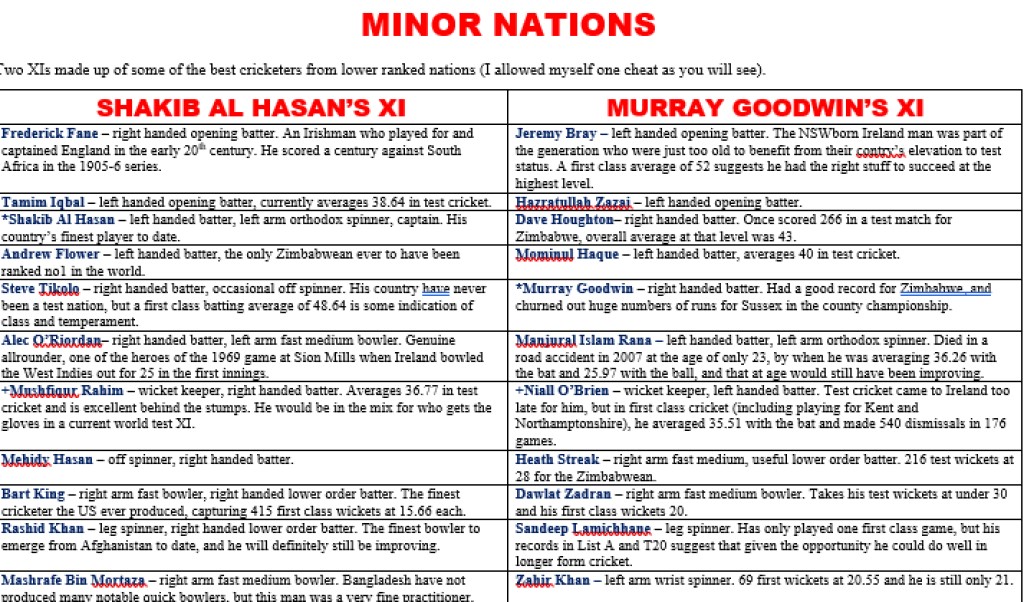Today’s world cup match saw Afghanistan facing the Netherlands. This post looks back at that match and at the fight for a semi-final slot. I did not catch a single ball of yesterday’s game in which India obliterated Sri Lanka (another “we’ll have a bowl” disaster at this world cup – India put in to bat tallied 357 from their 50 overs and Sri Lanka sank to 55 all out in response).
THE PRELIMINARIES
Afghanistan opted to go with four front line spinners, relying on Fazalhaq Farooqi and Azmatullah Omarzai to bowl such seam as was required. The Netherlands won the toss and chose to bat first, clearly the correct decision on a turner. However, winning the toss and making the right decision are the first two steps of a three-step process, with the third step, playing good cricket, by far the most important…
A DUTCH COLLAPSE
The Netherlands started very well, but the dismissal of O’Dowd, run out for a rapid 42, put the skids under them. That dismissal made it 73-2, and Colin Ackermann and Sybrand Engelbrecht put on 19 together before Ackermann became the second run out victim of the innings. Scott Edwards was then given Run Out first ball to make it 92-4. This was unlucky for Afghanistan keeper Ikram Alikhil, who pulled off a superb piece of work behind the stumps and deserved by credited with a stumping, but apparently Edwards had made contact with the ball, which meant that officially it had to be called a run out. Five runs later Bas de Leede played a wild shot at Mohammad Nabi and succeeded only in edging to Ikram Alikhil to make it 97-5. Saqib Zulfiqar offered Engelbrecht some support, but after scoring a very slow 3 he edged one from Noor Ahmad into the safe gloves of Alikhil and it was 113-6. Logan van Beek stayed while a further 21 runs accrued, of which his share was 2, before he was stumped by Alikhil. Roelof van der Merwe helped the Netherlands past the 150 mark, but shortly thereafter caused the run out of the determined Engelbrecht for 58 (86), and it was 152-8. Roelof van der Merwe and Aryan Dutt devoted themselves almost solely to seeing out overs at this point. The first really aggressive shot by either, from van der Merwe resulted in a lobbed catch to Ibrahim Zadran off Noor Ahmad to make it 169-9. Dutt and Paul van Meekeren cobbled together another 10 for the last wicket before Mohammad Nabi trapped van Meekeren LBW. The Dutch number 11 reviewed it, but it was plumb and the Netherlands were all out for 179 in 46.3 overs. 38.3 of those overs had been bowled by spinners, an all time record for a men’s world cup match. Ikram Alikhil had had a hand in six of the wickets, the three officially credited to him, and three of the four run outs (one was a direct hit throw from Azmatullah Omarzai), and with the four run outs and one official stumping this was the first ever men’s world cup innings in which as many as five batters had been out through being out of their crease at the wrong time. The Netherlands had lost their last nine wickets for 106 runs, and their last eight for 87.
THE AFGHANISTAN CHASE
Can be summed up with one word: clinical. Although both openers were out cheaply Rahmat Shah and Hashmatullah Shahidi had a fine partnership for the third wicket, and then Azmatullah Omarzai joined Shahidi in the stand that saw Afghanistan over the winning line with 18.3 overs to spare. Rahmat Shah scored 52 (54), Omarzai 31* (28) and Shahidi 56* (64), a thoroughly professional display from the numbers three, four and five for Afghanistan. This puts Afghanistan firmly in the mix for a semi-final slot. If they can beat either Australia or South Africa, their last two opponents, that will probably be enough for them. New Zealand look the most vulnerable of those currently in qualifying slots – they have lost three in a row, while India and South Africa are both guaranteed to qualify, and Australia could only be dragged into the dogfight for the fourth slot if they somehow lose against bottom of the table England tomorrow.
PHOTOGRAPHS
Just before I terminate this post, two posts ago I included in my gallery two street names which each connected to two cricketers. The connections are as follows: Wyatt Street – current England T20I women’s opener Danni Wyatt and former England men’s captain Bob Wyatt, and Archdale Street – England women’s first ever captain, Betty Archdale, and former long serving Somerset wicket keeper the reverend Archdale Palmer Wickham.
Now for my usual sign off…



















































































































































































































































































































































































































































































































































































































































































